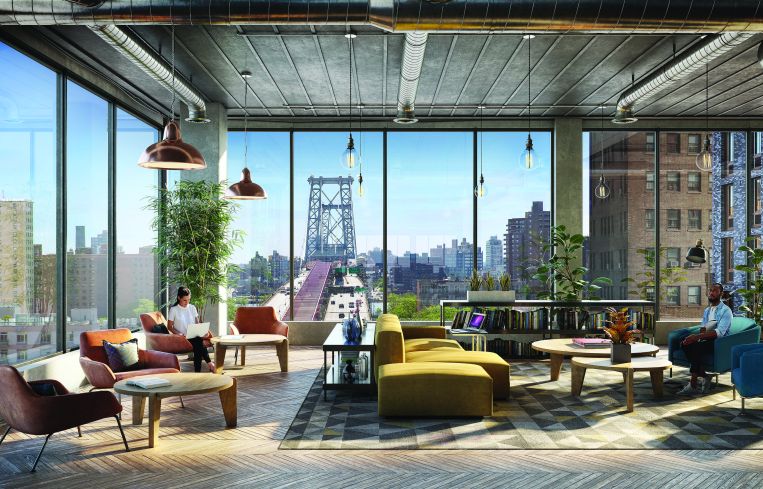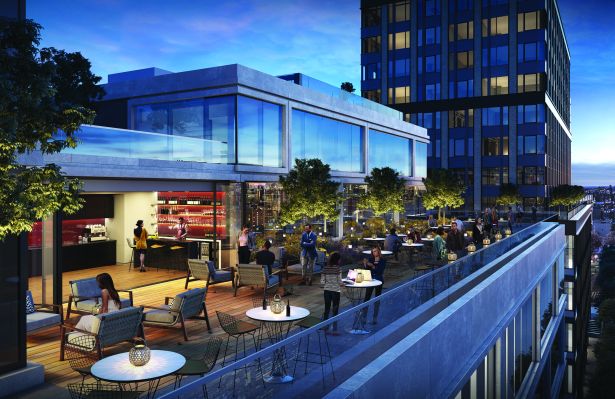How to Sell 350,000 Square Feet of New Class A Space During a Pandemic
The developers behind the Lower East Side's Essex Crossing know they have their work cut out for them
By Tom Acitelli October 19, 2020 7:43 am
reprints
A developer behind the 1.9 million-square-foot Essex Crossing, one of the largest new developments in Midtown South in recent memory and which includes the only large blocks of new Class A office space on Manhattan’s Lower East Side, knows it hit a wall with the pandemic.
“The office market is a major challenge right now, there’s no question,” Matthew Weir, Taconic Partners’ senior vice president for commercial asset management, said.
The company, which is building the project with L+M Development Partners and BFC Partners, is bullish nonetheless.
For one thing, what was swinging in Essex Crossing’s favor before the pandemic, including its amenities, scope and infrastructure, is still very much in the project’s favor now. There’s also that location right off the Williamsburg Bridge amid several subway lines. Finally, there’s the fact that no one really knows where the office market in Manhattan is headed.
Weir said that Essex Crossing — which includes two towers with five floors of office space at the base of each building, and 175,000 square feet at each of those blocks — enjoyed active interest before the pandemic. It was especially helpful that, by then, years of construction were culminating in a shell that the developers and its Cushman & Wakefield brokers could walk potential tenants through.
Most of the interest came from exactly who the developer was targeting — companies from the famed TAMI (technology, advertising, media and information) sector; and companies in other sectors with large, in-house tech operations. Weir declined to disclose specific interested tenants but did say that a couple of large ones were still considering leases.
The TAMI sector has long-animated Midtown South as well as the expanse between Midtown and Downtown in general. The submarket was home to the original Silicon Alley at the century’s start, and the sector claims an increasingly large share of the submarket’s leasing activity. In 2019, 60 percent, or 4.5 million square feet, of the 7.5 million square feet of office space secured in Midtown South was by TAMI tenants, according to brokerage Avison Young — much greater than the 37 percent from 2018. The TAMI shares from both years were also greater than what the sector accounted for leasing-wise in Midtown and Downtown.
What’s more, perhaps, the most significant Manhattan lease overall during the pandemic has been Facebook’s deal for 730,000 square feet at Vornado Realty Trust’s planned conversion of the old Farley Post Office in Midtown South.
“Facebook’s commitment is a further testament to New York City’s extraordinary talent, and reinforces New York’s position as the nation’s second tech hub,” Vornado Chairman Steven Roth said at the time of the August lease.
These TAMI firms keep slapping on jobs in the city, too. Amazon’s redo of the old Lord & Taylor flagship in Midtown South will house some 2,000 employees, the e-commerce colossus announced in August.
Despite these bright spots, though, things are gloomy in Manhattan in general, like in so many major U.S. markets.
Leasing activity in Midtown South dropped 94 percent annually in July, when companies leased just 30,000 square feet, according to brokerage CBRE. The latest Cushman & Wakefield data showed a Midtown South vacancy rate of 11.1 percent at the end of the third quarter, up from an already rising 9.2 percent the quarter before. Absorption of space in the submarket was -1.9 million square feet for the year as of Sept. 30, Cushman & Wakefield reported.
And few companies are returning workers to their Manhattan offices (or workers are choosing not to come in). Estimates the past few weeks have pegged only about 12 to 15 percent of the borough’s office space in regular use on any given workday seven months into the pandemic.
Still, new Class A space, such as Essex Crossing, with features that fit right into the post-COVID office environment, should play well once the market returns to a more normal ebb and flow, Weir said.
“The way I’m thinking about it is, the market, by and large, has yet to return to a functioning market,” Weir said. “You need buyers and sellers; you need lessers and lessees; you need a buy and an ask.”
In the meantime, Taconic expects Essex Crossing’s features to do the heavy lifting of helping to fill that 350,000 square feet. The five floors at 155 Delancey Street are expected to be move-in ready by the end of 2020, with the other floors online around the end of the first quarter or beginning of the second quarter in 2021.

The features — all planned before the pandemic made them that much more desirable to tenants — include access to outdoor space and modern HVAC systems that individual tenants can control and can accommodate ultraviolet light. The available spaces range from 35,000 to 52,000 square feet, fostering flexibility for tenants.
Also, at five stories, these office chunks are decidedly low-rise in a post-COVID era that suddenly rewards such scope. Fewer companies and their employees want long elevator rides with strangers tight beside them.
“We have absolutely seen at Essex and at other properties in our portfolio, all of sudden, people are specifically coming to your buildings to look at the second or third floor,” Weir said. “The features and the fundamentals of this project are really well-placed and well-positioned post-COVID.”
Asking rents in the project have yet to be determined until some normalcy returns to a market that’s seen relatively few leases and is increasingly awash in sublease space. Before the pandemic, Taconic was asking for a dollar amount in the high 90s per square foot, Weir said. Now, it remains to be seen.
“In terms of repricing the market,” Weir said, “it’s going to be a dynamic discussion, and it really hasn’t started yet.”



